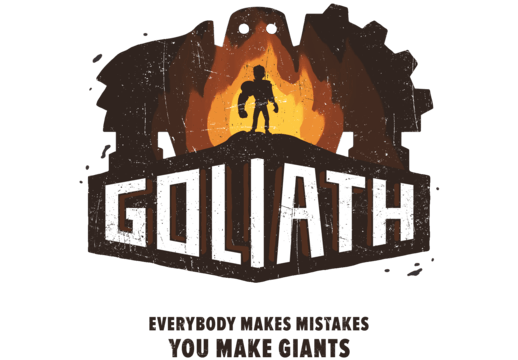I love mechas. Ever since I watched Megas XLR back in the mid-2000s my number one chant was always “I love giant robots,” and since Mechwarrior isn’t really around anymore (no, you will never get me to play Mechwarrior Online) there haven’t been many creative mecha games. Since my love of mechas will never die, I have always felt sort of empty as a result.
When I found out that Whalebox Studio in Novosibirsk, Siberia, was making Goliath I just had to check it out.
Goliath is an open-world action-adventure game for the PC that blends survival and role-playing elements into a game about building gigantic robots. In a world where massive monsters are an everyday occurrence, Goliaths stand as your chance of equalizing the playing field. While your customization options are at first limited to wood and stone, players can expect to build their robots with hardier materials as they progress through the game.
When they said massive monsters I didn’t expect this!
I decided to contact Whalebox Studio’s marketing manager, Jeremy Zoss, via e-mail to ask him about the game. The following is a direct quotation of the discussion (images have been added for the sake of clarity and context).
David: One of the core features of Goliath is the ability to create customized robots of your own. What sort of customization options will players have at their disposal, aside from weapons and armor?
Jeremy: Lots! There are four basic Goliath types: Wood, Metal, Stone and Crystal. Each of these types has roughly 15 variants, all of which have unique properties. For example, the basic wooden Goliath is vulnerable to fire, but you can unlock a version made from burned wood. This version is obviously more fragile, but is immune to fire damage and does bonus heat damage to attacks.
Another example is the explosive stone Goliath, which is covered in bombs. You can jump out of this Goliath and send it into a group of enemies to detonate and take them all out. There are sniper Goliaths with long-range weapons and night vision, super armored melee Goliaths, and much more.

You can mix and match parts from each of the variants within a type for hundreds of combinations, so you might make a wooden Goliath with flaming arms, a sniper head and reinforced brawler body and faster legs. So there are way more options than just weapons and armor!
So what about the survival aspect of the game? What can players expect from this? Will we be forced to find food, shelter, or other basic needs to survive? Or is this simply a “fight for survival” type game? If this is a survival game in which we need food and other survival needs, what separates Goliath from other games like Lost in Blue or Don’t Starve?
We wanted to make Goliath more approachable that some other survival games. You don’t need to sleep, eat or monitor your sanity. We didn’t want you to have to stop fighting in your awesome robot because you need to eat something. So the survival aspects mostly present themselves in the form of maintenance and crafting. There’s no automatic healing or repair (with one exception), so you have to find the ingredients to create healing items and repair kits and craft them. You also obviously need to craft the items that make survival easier, like tools, weapons, and of course, Goliaths.
Weather is one of the systems you have in your game. What sort of effects – if any – will weather have on the Goliaths?
The weather effects all have different effects on the various Goliath types. For example, the wooden Goliath is obviously the most vulnerable to heat. Not only does it take more damage from fire-breathing monsters, it can also start on fire if it spends too much time in a hot environment like a desert. But the heat actually provides bonuses to the stone and metal Goliaths. When the stone Goliath heats up, the rocks that make up his body become hotter and he inflicts heat damage with his attacks. The metal Goliath is powered by an internal furnace, so when it becomes hot enough, it burns fuel faster and gets a temporary speed boost. In the rain, the metal Goliath can rust, but the wooden Goliath regrows and repairs damage. There are positive and negative effects for each weather condition based on which Goliath you are using.
So is it possible for a Goliath to become a jack-of-all-trades? Or will players have to make multiple Goliaths designed for different uses?
Players can have three Goliaths at a time and switch between them on the fly, so we expect that most players will develop a variety of Goliaths they use for different situations. But one of those can definitely be an all-around solid Goliath that’s good for most combat situations. The metal Goliath is pretty well-rounded to start – it’s faster than stone Goliath but not as strong; stronger than the wooden Goliath but not as fast.
In addition to building Goliaths, you’ll also build a base where you can store the Goliaths you’re not using. So while you can have three with you at any given time, you can have many more Goliaths waiting for you if you need even more options!
On your Kickstarter page, you mention that you have plans for co-op and competitive multiplayer modes. What can players expect from these modes?
The main multiplayer mode is co-op for up to four players. It works very similar to Borderlands, with one player serving as the host and the other three entering the host’s word. Since Goliath is a procedurally generated game, everyone’s world will be different, and that includes different procedurally generated quests. The three players who join the host’s world will have access to procedurally generated quests that won’t appear in their world, and any loot they earn is available back in their single-player game, or games with other players. The next time the group plays together, they can let another player host, and then there will be a whole new set of procedurally generated quests and rewards available. So you’re not only rewarded for playing multiplayer, you’re rewarded by playing with a variety of other players.
As for competitive multiplayer, we have a lot of fun ideas for more arena-based combat. Expect to see smaller maps with much more of a focus on combat over quests or exploration.
Your campaign only has 14 days left until completion. How dependent is your team on the Kickstarter’s success?
We have the funding to complete Goliath with or without the Kickstarter funding, but if the campaign isn’t successful, some of our dream features will be cut. Competitive multiplayer is one of the major ones. We have a lot of fun ideas in this area, but most of them won’t make the cut without a successful Kickstarter. We also want to add more Goliaths and more playable character with Kickstarter funding, and also hire an amazing comic book writer to work on the script and a talented composer for an original score. We hope that readers will like what they’ve heard about Goliath and decide to help us make our game the best that it can be. So please, support us on Kickstarter!
According to Jeremy Zoss, Goliath can be expected to be released on Steam for PC, Mac, and Linux in the earlier part of 2016. While the game already looks great as is, a lot of their Kickstarter campaign goals look like genuinely interesting features that I would love to see in the final release. If you would like to help Whalebox Studio fund their dream goals, then you can follow this link to their Kickstarter page, or click on the widget on the right.











Published: Sep 2, 2015 08:36 am